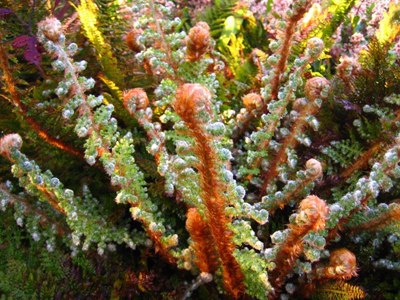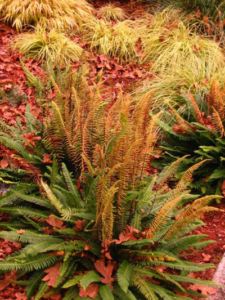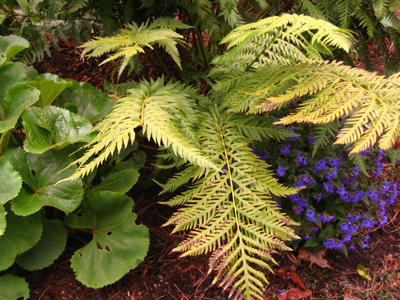A Fondness for Ferns
By Laurie
Ferns are emotive plants that can conjure up visions of other places and times. Ferns give a garden a sense of permanence, timelessness, of always having been there; which is no wonder, as they have been around for over 300 million years!
Ferns don’t seduce us with flowers, but instead offer exquisite fiddleheads and gorgeous texture. They are elegantly diverse, the quintessential shade foliage plant that comes in all shapes and sizes. They are classy plants with a long season of interest, starting with their intricate unfurling fronds in spring.
Their refined fountain shapes make a strong architectural statement that can soften formal designs and add polish to spare sites. Airy fronds move in the breeze and contrast well with smooth walls, water features and stone. Ferns have a regular, reliable growth habit and won’t outgrow their assigned space very quickly, which makes them easy to place and partner with other plants. In addition to all of these wonderful attributes, ferns are rarely bothered by pests, diseases and deer!
There is a fern for almost every garden situation. They are easy to grow, adaptable and low maintenance. Although the ideal site for a fern is in dappled shade with consistent moisture in well drained soil, they will also grow in full to part shade, and some will even take sun. There are even ferns for difficult places like dry shade, drier sun, wet boggy areas, and clay slopes.
Ferns like a regular amount of moisture especially in their first year, but many can take some drought once established. They appreciate a compost or leaf mould mulch in spring but don’t require any extra fertilizer. Unlike shrubs, ferns don’t need pruning or deadheading. Cutting back their deciduous and evergreen fronds in spring (March) when the ‘knuckles’ appear is the only work needed.)
Ferns are versatile and can be used in a variety of ways. (See lists of ferns for different uses at the end of this article.) Small charmers can be tucked in containers or crevices or used to edge a shady path. More robust spreading ferns can create a unifying ground cover for naturalizing under trees or along a stream bank. The upright fountain shapes of many larger ferns can be dotted through a border and show best when they rise above smaller mounding shade plants.
Taller ferns are great inter-planted amongst spring bulbs as their spreading fronds cover the dying bulb foliage. Ferns can always be used to fill a difficult shady corner, but they can also add long lasting interest as a specimen at a shady entrance or to frame the sides of steps.
As is often the case, repetition is important. A grouping of three or more ferns repeats their strong, textured pattern and form, which can be a unifying element in a border. Their graceful, finely textured, matte fronds contrasted nicely with larger, simpler, glossy leafed plants.
Despite all their charms, ferns are underappreciated and underused in our gardens. Perhaps it is too difficult for us in the Pacific Northwest to get beyond the vision of “sword ferns everywhere”.
And, while there is no denying the charms of sword ferns, the world of ferns is so much more. Ferns are simply too captivating to ignore. Find a spot for one (or several!) in your garden and you will never look back.
FERN LISTS FOR DIFFERENT SITUATIONS:
FERNS – SUN TOLERANT (with some moisture)
Asplenium trichomanes – Maidenhair Spleenwort
Athyrium filix-femina – Lady Fern
Cheilanthes tomentosa – Wooly Lip Fern
Dryopteris affinis and cultivars – Golden Scaled Male Fern
Dryopteris x complexa and D. x complexa ‘Robusta’– Robust Male Fern
Dryopteris erythrosora varieties – Autumn Fern
Dryopteris filix-mas and cultivars – Male Fern
Onoclea sensibilis – Sensitive Fern
Osmunda cinnamonea – Cinnamon Fern
Osmunda regalis – Royal Fern
Polypodium glycyrrhiza – Licorice Fern
Polystichum munitum – Sword Fern
FERNS FOR WET SOIL
Athyrium filix-femina – Lady Fern
Dryopteris cristata – native
Matteuccia struthiopteris – Ostrich Fern
Onoclea sensibilis – Sensitive Fern
Osmunda cinnamonea – Cinnamon Fern
Osmunda regalis – Royal Fern
Osmunda claytoniana – Interrupted Fern
Adiantum aleuticum – Maidenhair Fern – takes moist, not wet
Dryopteris affinis – Golden Scaled Male – takes moist, not wet
Woodwardia fimbriata – Giant Chain Fern – takes moist, not wet.
FERNS FOR DEEP SHADE
Adiantum aleuticum – Maidenhair Fern
Asplenium scolopendrifolium – Harts Tongue Fern
Athyrium filix-femina – Lady Fern
Blechnum splicant – Deer Fern
Crytomium species – Holly Fern
Dryopteris dilatata – Broad Wood Fern
Dryopteris filix-mas – Male Fern
Gymnocarpium dryopteris – Oak Fern
Polypodium glycyrrhiza – Licorice Fern
Polystichum acrostichoides – Christmas Fern (for slopes, erosion control)
Polystichum braunii – Brauns Holly Fern
Polystichum munitum – Sword Fern
Polystichum setiferum – Soft Shield Fern
FERNS – DROUGHT TOLERANT (once established)
Athyrium filix-femina – Lady Fern
Dryopteris crassirhizoma – Thick Stemmed Wood Fern
Dryopteris filix-mas – Male Fern
Polypodium glycyrrhiza – Licorice Fern
Polystichum braunii – Brauns Holly Fern
Polystichum munitum – Sword Fern
FERNS FOR GROUND COVER (either low growers or spreaders)
Adiantum venustum – Himalayan Maidenhair Fern
Athyrium filix-femina – Lady Fern
Blechnum spicant – Deer Fern
Gymnocarpium dryopteris – Oak Fern
Matteuccia struthiopteris – Ostrich Fern
Onoclea sensibilis – Sensitive Fern
Osmunda claytoniana – Interrupted Fern
Polypodium glycyrrhiza – Licorice Fern
Polystichum munitum – Sword Fern
Woodwardia areolata – Netted Chain Fern
FERNS FOR COLOUR
Athyrium ‘Branford Beauty’
Athyrium ‘Ghost’
Athyrium niponicum ‘Pictum’ varieties – Japanese Painted Ferns
Athyrium otophorum – Eared Lady Fern
Cheilanthes tomentosa – Wooly Lip Fern
Dryopteris erythrosora varieties – Autumn Fern
Dryopteris lepidopoda – Sunset Fern
Dryopteris wallichiana – Wallichs Wood Fern
Onoclea sensibilis – Sensitive Fern
Osmunda regalis ‘Purpurascens’– Purple Stemmed Royal Fern
FERNS FOR SPECIMENS (striking appearance, large to medium size)
Dryopteris crassirhizoma – Thick Stemmed Wood Fern
Dryopteris x complexa ‘Robusta’– Robust Male Fern
Dryopteris wallichiana – Wallichs Wood Fern
Osmunda cinnamonea – Cinnamon Fern
Osmunda regalis – Royal Fern
Polystichum setiferum Divisilobum Group – many striking varieties
Polystichum makinoi – Makinois Holly Fern
Polystichum neolobatum – Asian Saber Fern
Woodwardia fimbriata – Giant Chain Fern
FERNS FOR CONTAINERS (use equal mix of soil,compost and bark mulch)
Adiantum aleuticum – Maidenhair Fern
Asplenium scolopendrifolium – Harts Tongue Fern
Asplenium trichomanes – Maidenhair Spleenwort
Athyrium filix-femina ‘Frizelliae’– Tatting Fern
Athyrium ‘Ghost’
Crytomium species
Dryopteris erythrosora varieties – Autumn Fern
Dryopteris lepidopoda – Sunset Fern
Dryopteris filix-mas ‘Cristata Martindale’
Osmunda regalis – Royal Fern
Polystichum setiferum cultivars
Polystichum tsus-simense – Korean Rock Fern
Polystichum polyblepharum – Tassel Fern
(Sources: Olsen, Encyclopedia of Garden Ferns/ Hardy Fern Foundation/internet)





